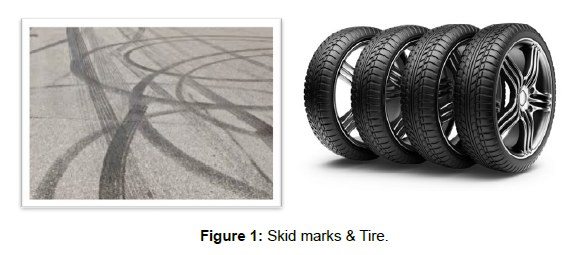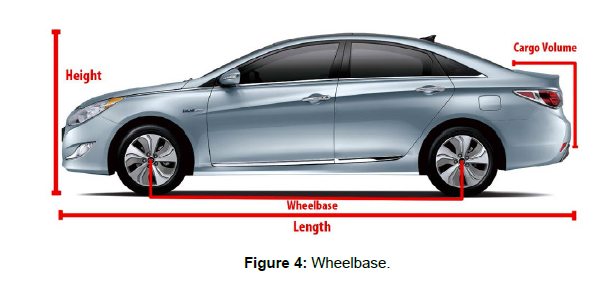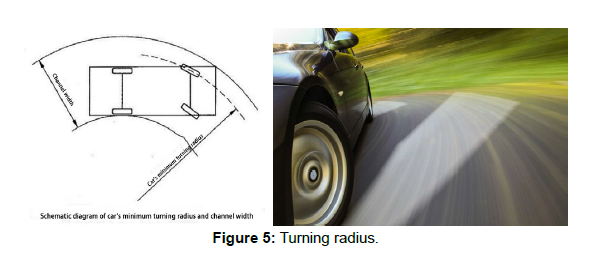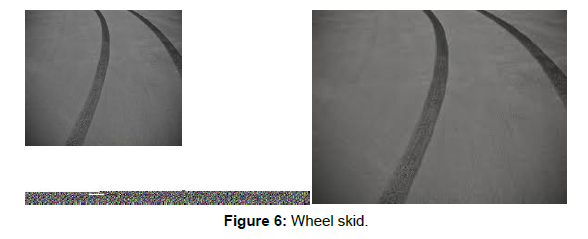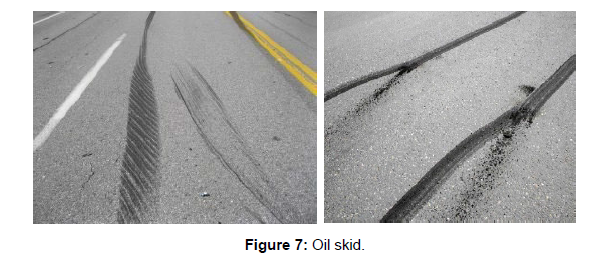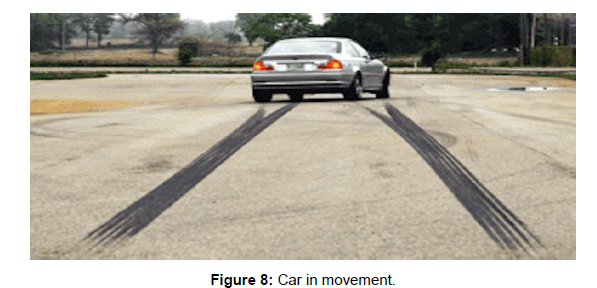Skid Marks and Reconstruction of an Accident
Received: 02-Dec-2022 / Manuscript No. gnfs-22-83581 / Editor assigned: 05-Dec-2022 / PreQC No. gnfs-22-83581(PQ) / Reviewed: 19-Dec-2022 / QC No. gnfs-22-83581 / Revised: 24-Dec-2022 / Manuscript No. gnfs-22-83581(R) / Published Date: 29-Dec-2022
Abstract
Skid marks play a crucial role as evidence in car accident on road. When the brakes of a car are applied suddenly then the wheels of the car are locked. The friction between the tire and road heated the rubber, depositing a thin layer of rubber particles. This black colour layer is skid mark. Anti-lock braking system (ABS) confines braking, locking and skidding by activating and deactivating the brakes several times per second. The study of skid marks left on pavement after an accident occurs that help professionals to reconstruct the accident. The skid mark provides evidence of distance over which braking took place. It means, the distance travelled by the vehicle from the moment of full application of brakes to the moment of vehicle come to a stop. The speed of the car at the moment of accident, also determine from the skid mark. Yaw marks produce when a vehicle travels in a curved path faster than the tires can handle. The different types of tire marks also depend on drag factor and braking efficiency of a vehicle.
Keywords
Skid marks; Reconstruction of accident; Yaw marks; ABS; Tyre scrubs; Braking efficiency; Drag factor
Introduction
A skid mark is the visible mark left by any solid which moves against another, and is an important aspect of trace evidence analysis in forensic science and forensic engineering. Skid marks caused by tires on roads occur when a vehicle wheel stops rolling and slides or spins on the surface of the road. Skid marks can be analysed to find the maximum and minimum vehicle speed prior to an impact or incident. Skidding can also occur on black ice or diesel deposits on the road and may not leave a mark at all. Skid marks are divided into "acceleration marks" created on acceleration, if the engine provides more power than the tire can transmit; "braking marks", if the brakes "lock up" and cause the tire to slide; or "yaw marks", if the tire slides sideways. Each skid mark has a characteristic appearance, and an experienced accident reconstruction or forensic engineer can often determine what the vehicle was doing by examining the marks left by the tire. The tire marks are produced when a tire slide across a paved surface, leaving dark rubber particles on the pavement. Similar to the way an eraser leaves particles on a piece of paper.
Types of tire marks: skid marks, yaw marks & tire scrubs
Skid marks
When the brakes of a car are applied suddenly then the wheels of the car are locked [1]. Car loses the ability to steer further. The car will slide straight ahead. Skid marks are usually straight which provide the evidence of the distance over which braking took place. Antilock brake system (ABS) [2] prevents braking and locking and skidding by turning the brakes on and off several times a second. The driver can maintain steering control. Vehicle equipped with ABS may leave faint intermittent skid marks. These skid marks may be a curve path [Figure 1].
Yaw marks
Yaw marks occur when a vehicle travels in a curved path faster than the tires can handle [3]. The adhesion limit of the Tire is reached, so they begin to slip. Tire squeal and leave marks on the pavement. Yaw marks are always curved. There are often striations at an angle to the length of the mark.
Tire scrubs
Tire scrubs are caused by a damaged or overloaded tire. They happen during or immediately after collision. These are usually curved and irregular width. These have striations at an angle. These are produced by a damaged or overloaded tyre during or immediately after impact. These are curved, irregular in width and may have striations that look like stripes to determine the area of impact.
Drag factor
“Drag Factor” is a numerical value for the rate at which the flywheel is decelerating. This number changes with the volume of air that passes through the flywheel housing. Tires slides on some road surface easier than others. It depends on the road surface and constitutes of the road materials, types, materials and grooving patterns of the tier itself.
Braking efficiency
The braking efficiency is the ability of the brake to reduce the vehicle speed to earliest stop to maintain a certain speed of the descending vehicle on a slope, or to keep the vehicle on a slope. To calculate braking efficiency, divide the total vehicle weight by the brake effort, then multiply by 100 [Figure 2].
Different road surfaces produce different kinds of skid marks, sometimes also referred to as scuff marks or tire marks. On asphalt road surfaces, skid marks are usually the result of bituminous oils in the asphalt that are heated because of the friction of braking or accelerating and rise to the surface, leaving dark marks. This kind of mark on asphalt can last for months or even a year or two if they are particularly dark and the roadway is not well travelled. On other road surfaces, such as concrete, the marks result from the deposition of tire compounds onto the surface of the roadway. This kind of skid mark is typical of airport runways, which need to be periodically cleaned to remove deposited debris that reduces the frictional coefficient of the runway. The durability of these marks depends on a number of factors, including road use, tire compounds, weather, and frequency of road cleaning.
Some basic information to understand this
1. Skid marks
the starting of break marking on the road when the driver see the object/person who has suffered accident up to the distance the car totally stop due to the breaking action. That is if there is skid marks on the road has seen by the investigating officer then it is taken that the driver has tried to save the life, if there is no skid marks on the road, then it is taken that it is the intention of the driver to murder him and he didn't tried to save the life by putting break.
2. The distance between two Tire marks reveals that it was done by small car or truck as you know the distance between left tire and right Tire is different in case of truck and small car.
3. The impression of Tire pattern is different for different company and also depends for which it is designed i.e. whether small car and large car and also on the surface where it is to be used as you know the road surface inside airport is different from our normal road, as frictional force depends on the roughness.
4. If we find Tire scrubbing on the road then conclude that "used tire named as cuta Tire on the road side kept for selling has been used which cross it's life time, not new one this is same as the scrubbing marks on the paper by dry or old rubber.
5. If car trying to turn all of a sudden or overtaking another car then also some yaw marks pattern can be seen on the road.
Accident reconstruction in case of ‘hit and run’ case
Vehicle identification: Tire impression can identify the make and model of a vehicle associated with crime
Scene [4]. Some identifying characteristics are front and rear track width, centre of left tire to the centre of the opposite right tire.
There are three basic types of tire marks:
• Skid marks – provides the information about the distance when brakes were applied and the vehicle’s speed.
• Yaw mark - can solve a sideways skid.
• Tire scrub - can determine the area of impact.
Such marks are important evidence for vehicle accident reconstruction, when their size and shape can reveal much about vehicle speed and forces of acceleration or deceleration. They are one form of trace evidence. They represent a form of contact evidence produced according to Locard's exchange principle [5]. The length of the skid mark is usually closely related to the vehicle speed at the instant of braking, skid mark formed when someone brakes suddenly & locks the wheels show distance the breaks were applied. Used this distance in calculating the speed of vehicle just before the brake applied [Figure 3][6].
Braking marks will vary depending on whether the car uses ABS or not. If not, there will be two lines. The darker marks on the outside are from the front wheels, while the back tires leave thinner marks. This is because the force exerted makes the wheels take on a conical shape. If the car uses ABS, the marks will be much fainter as less heat is produced by the release-stop mechanism of ABS. Scuff marks may be visible however with ABS [2].
Wheelbase
In both road and rail vehicles, the wheelbase is the horizontal distance between the centres of the front and rear wheels [7]. For road vehicles with more than two axles (e.g. some trucks), the wheelbase is the distance between the steering (front) axle and the centre point of the driving axle group. In the case of a tri-axle truck, the wheelbase would be the distance between the steering axle and a point midway between the two rear axles.
The wheelbase of a vehicle equals the distance between its front and rear wheels. At equilibrium, the total torque of the forces acting on a vehicle is zero. Therefore, the wheelbase is related to the force on each pair of tires by the following formula:
Ff=[dr/L]mg, Fr=[df/L]mg
Where Ff is the force on the front tires, Fr is the force on the rear tires, L is the wheelbase, dr is the distance from the center of mass (CM) to the rear wheels, df is the distance from the centre of mass to the front wheels (df+dr=L), m is the mass of the vehicle, and g is the gravity constant. So, for example, when a truck is loaded, its center of gravity shifts rearward and the force on the rear tires increases. The vehicle will then ride lower. The amount the vehicle sinks will depend on counter acting forces, like the size of the tires, tire pressure, and the spring rate of the suspension. If the vehicle is accelerating or decelerating, extra torque is placed on the rear or front tire respectively [Figure 4].
The equation relating the wheelbase, height above the ground of the CM, and the force on each pair of tires becomes:
Ff=[dr/L]mg – [hcm/L]ma, Fr=[df/L]mg + [hcm/L]ma
where Ff is the force on the front tires, Fr is the force on the rear tires, dr is the distance from the CM to the rear wheels, df is the distance from the CM to the front wheels, L is the wheelbase, m is the mass of the vehicle, g is the acceleration of gravity (approx. 9.8 m/s2), hcm is the height of the CM above the ground, a is the acceleration (or deceleration if the value is negative). So, as is common experience, when the vehicle accelerates, the rear usually sinks and the front rises depending on the suspension. Likewise, when braking the front noses down and the rear rises.
Identification of vehicle
Some identifying characteristics: Turning diameter: measure of how tight a circle can be driven or minimal pace required to make a U turn. The larger the wheelbase, the larger the turning diameter [Figure 5].
Ladder accidents
Skid marks can also be formed where a ladder suddenly slips and the user falls to the ground, especially if the ladder feet are faulty or absent. Loss of the rubber feet or foot causes the tiles to make contact with the ground, and if a hard surface like concrete a skid mark shows how and why the ladder slipped. Unless fixed to the wall upon which they are leaning, ladders can slip down easily, especially if the ladder is leaned at an angle lower than about 75 degrees. Such slip accidents tend to happen when the user is near the top of the ladder, increasing his or her chances of serious personal injury [Figure 6][8].
Establishing car movement from tire track
A vehicle direction of travel can be determined from
• Vegetation disturbed as vehicle entered or left the road
• Debris pattern cut off by a moving car
• Splash patterns
• Substance transfer [Example Oil leaking from vehicle to pavement]
• Tire marks left [Figure 7].
36.7 miles per hour [59 kilometres per hour]
• It is important to understand that this is a minimum speed for the car at the beginning of the skid.
• Since the driver is likely to have applied the brakes before the locked and skidded, his speed was certainly greater than 36.7 mph before he started breaking [Figure 8] [9].
Measuring skid mark
If 4 marks are found, they should be measured individually to get the average skid distance to calculate the velocity at the time of meeting with an accident [10].
Summary
One of the most common tasks in accident reconstruction is the estimation of vehicle speed from measured braking skids marks and maximum information about the vehicle. This involves careful measurement and proper use of formulas to arrive at valid conclusions.
References
- khusi M (2020) “Importance of Tire Marks in Forensic Investigation ". Legaldesire com 8: 856-863.
- Jun Xu, Yibing Li, Guangquan Lu, Wei Zhou (2009) “Reconstruction model of vehicle impact speed in pedestrian – vechile accident ". International Journal of Impact Engineering 36: 783-788.
- Lee Seung-Jong, Jeong-seop H (2003) “The vehicle accident reconstruction using skid and yaw marks". Journal of the Korean Society for Precision Engineering 20: 55-63.
- Dudoka CV (2017) "Automotive Engineering for Improved Safety". Paper NMV17SAF13 26(1): 8.
- Mistek-Morabito E, Fikiet MA, Khandasammy RS, Lednev IK (2018) “Toward Locard’s Exchange Principle: Recent developments in forensic trace evidence analysis". Analytical Chemistry 91: 1.
- Cohen HH, Lin L (1991) “A scenario analysis of ladder fall accidents". Journal of Safety Research 22: 31-39.
- Yang X, Luo J, Yang J, Shanshan P (2021) "Effects of wheelbase size on left rear-seat occupant injury risk in small offset crashes". Proceeding of the institution of Medical Engineers Part D Journal 236: 3.
- Garrott WR, Guenther DA (1982) "Determination of Tire-Road Friction Coefficients for Skid Mark Analysis". National Highway Traffic Safety Administration.
- Hutchinson NG, Tsongos, Bennett NC, Fogarty WJ (1975). "Pavement Surface Information Needs in Accident Investigation ". American Society for Testing and Materials, Chicago, IL.
- Sharma B, Chand D, Bashir R, Shafiq E (2019) "Analysis of overlapped tire marks characteristics with the aid of enlarged photography". International Journal of Recent Technology and Engineering 7: 6.
Indexed at, Google Scholar, Crossref
Indexed at, Google Scholar, Crossref
Indexed at, Google Scholar, Crossref
Indexed at, Google Scholar, Crossref
Indexed at, Google Scholar, Crossref
Indexed at, Google Scholar, Crossref
Citation: Dhabal S, Sen DJ, Chakraborty S (2022) Skid Marks and Reconstruction of an Accident. Glob J Nurs Forensic Stud, 6: 206.
Copyright: © 2022 Dhabal S. This is an open-access article distributed under the terms of the Creative Commons Attribution License, which permits unrestricted use, distribution, and reproduction in any medium, provided the original author and source are credited.
Select your language of interest to view the total content in your interested language
Share This Article
Open Access Journals
Article Usage
- Total views: 21708
- [From(publication date): 0-2023 - Dec 19, 2025]
- Breakdown by view type
- HTML page views: 20988
- PDF downloads: 720

